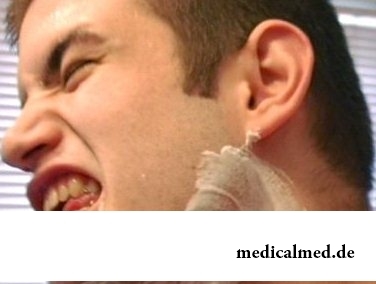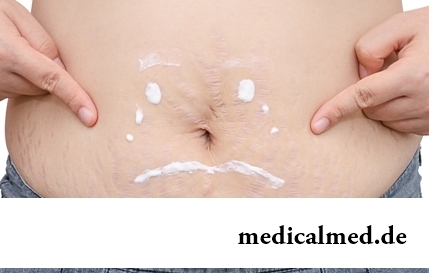





Turett's syndrome

Turett's syndrome – psychological frustration at which the person makes the involuntary movements or makes involuntary sounds, realizing the actions, but not having an opportunity to control them. The involuntary movements in this case are called tics.
Turett's syndrome it occurs rather often, at 0,05% of the population. Turett's syndrome at children aged from 2 up to 5 years is most often shown, the following peak is the share of teenage age, from 13 to 17-18 years.
Boys get sick with Turett's syndrome three times more often than girls.
Origins of a syndrome of Turett
Doctors consider that the main origin of a syndrome of Turett – genetic predisposition. It is confirmed by the fact that in most cases it, or other neurologic diseases accompanied with tics occur at relatives of the first and second lines of the patient. Turett's syndrome can develop also after reception of some types of medicinal substances, for example, of neuroleptics. Some specialists consider also possible origin of a disease autoimmune processes, but so far proofs of the similar theory do not exist.
Clinical picture of a syndrome of Turett
As a rule, the first signs of a syndrome of Turett at children at early age, after two and up to five years are shown. Parents pay attention to strangenesses in behavior: twitchings, the persuasive, repeating movements. It can be grimacing, winking, twitching, cottons hands, jumping, frequent blinking, even blows in a face and a body. Sometimes Turett's syndrome proves as the repeating pronouncing various sounds: groans, rumbling, gurgle, repeated repetitions of the same words and phrases, an echolalia – repetition for someone phrases, at advanced age can appear an eschrolalia – bawling out of curses. The person realizes at the same time the actions, and estimates them as abnormal, but cannot control.
Usually patients with Turett's syndrome feel approach of a tic, and can sometimes postpone it, but not suppress completely. Similar uncontrollable actions forced to assume in the Middle Ages that in the person the demon as patients often describe an attack as something that induces them to commission of strange actions violently, in addition to their will was installed.
Turett's syndrome can wavy proceed when the aggravation periods with frequent attacks of tics are replaced by the zatikhaniye periods, in other cases of display of a disease are constant. Dependence on age is noted, in most cases the disease ceases after the puberty period, and can only occasionally, prove during the periods of emotional instability tics and that, as a rule, weak. Thus, Turett's syndrome occurs at children several times more often than at adults.
At Turett's syndrome does not suffer intellectual and mental development of the child, there is only a psychological problem in communication with peers when, understanding the difference from others and without being able to overcome it, the child begins to feel defective, becomes isolated and suffers from a depression. For the rest such children differ in nothing from peers, and are capable as well as all others, to try to obtain great success that is confirmed by the fact of existence of a syndrome of Turett at many celebrated personalities.
Diagnosis of a syndrome of Turett
The diagnosis of a syndrome of Turett is made on the basis of a characteristic clinical picture after a year of observation of the patient. At the first request for medical care to patients with similar symptoms surely conduct neurologic examination to exclude organic lesion of a brain, for example, owing to tumoral process. At Turett's syndrome, as a rule, it is not possible to reveal any deviations, only in small percent of cases deviations in striate bodies of a brain are defined.
Treatment of a syndrome of Turett

In spite of the fact that symptoms of a disease are known since ancient times when they were treated as obsession by demons and as a disease Turett's syndrome was described in 1885, attempts of its treatment began only at the end of the 20th century.
Specific treatment of a syndrome of Turett does not exist. In most cases reception of pharmacological drugs is undesirable, especially long time as they have side effects, from which harm much more, than therapeutic effect. Usually drug treatment of a syndrome of Turett it is applied during an acute state, to muting of symptoms. Antipsychotic means and sedative (soothing) drugs are for this purpose used.
The main method of treatment of a syndrome of Turett at children is the psychotherapy directed to that the child did not feel defective and learned to treat the disease adequately, without putting the life into dependence on it. Such therapy, despite the seeming secondariness, is very important as at children who treat a disease more simply and are able, despite it, to adjust communication with peers and to lead usual life, disease symptoms pass much more often with age. Besides, the psychotherapy trains the child of an opportunity to muffle disease symptoms, redirecting pathological activity to more appropriate bed.
Even more often at treatment of a syndrome of Turett resort to game methods: to specially developed games, an animaloterapiya (medical communication with animals), a skazkoterapiya, art therapies also we designate. Such methods help social adaptation of the child and prevent emergence of secondary psychological problems. The good effect is rendered by moderate sports activities, and also playing musical instruments, especially wind.
Attempts of treatment of a syndrome of Turett by surgical methods, and also by direct electric impact on structures of a brain were made. In some cases they were effective, but however did not find broad application as the risk of damage of the vital centers of a brain is too high.
When lovers kiss, each of them loses 6,4 calories a minute, but at the same time they exchange nearly 300 species of various bacteria.

It seems, quite recently you brought the baby from maternity hospital, but time flew by, and here it is already going to join the first...
Section: Articles about health
Let's begin with the fact that a separate illness which is called "adjournment of salts", just does not exist. In practice this household name of disbolism leading to development of a number of diseases. Pathological process consists that in an organism проис...
Section: Articles about health
Osteoporosis this general disease which main sign is decrease in density of a bone tissue. On distribution width it takes the fourth place among noninfectious diseases. The illness develops at mature age more often: in our country about a third of women and a quarter of men suffers from it 50 years are more senior....
Section: Articles about health
Visit of doctors – business not the most pleasant, and many people do not hurry to undergo necessary planned inspections. Such behavior...
Section: Articles about health
The business lady, the become mother, it is necessary to solve an array of problems. But of them is main: how to combine the beloved child and work? What traps trap the working mother and how she needs to behave?...
Section: Slideshow
The mankind knows that some toxins at intake in the minimum quantities have therapeutic effect from an extreme antiquity. Many substances recognized poisonous are applied in the medical purposes also today, being the main operating components of the medicines which are officially produced by pharmaceutical industry. Let's tell only about the most known of them....
Section: Articles about health
The trophic ulcer is not an independent disease. This heavy complication arising owing to a thermal injury (a burn...
Section: Articles about health
It is pleasant to state a possibility of improvement of quality of life of people with problems of functioning of secretory system. Efforts of talented inventors created products which will be able to provide normal life activity of clients with moderate degree for...
Section: Articles about health
For the person who daily since morning gathers for work it is very important to wake up vigorous and ready by day of work. Actually, each of us experiences difficulties with this, at first sight, simple business from time to time. After night rest exert impact on a condition of an organism the weather which collected for several days fatigue, household and office problems, quality of a dream and many other factors....
Section: Articles about health
Obesity is called by a disease of 21 centuries, for the last 100 years by the number of the people suffering from excess body weight, considerably increased...
Section: Articles about health
The problem of diagnosis was and remains to one of the most important in medicine. From that, the reason of an indisposition of the patient will be how precisely defined, eventually success of treatment depends. In spite of the fact that the majority of the diagnostic methods applied in about...
Section: Articles about health
Feeding by a breast - the integral part of ideal motherhood allowing to come into contact with the kid and to create to it healthy immunity since early years. Nevertheless, this important process in life of mother and child can be saddened laktostazy − by a milk delay in a mammary gland. What main reasons for a laktostaz? How not to allow problems with breastfeeding? Let's consider 10 premises resulting in stagnation of milk at the nursing mother....
Section: Articles about health
Heart disease and blood vessels lead to disturbance of blood supply of bodies and fabrics that involves failures in their works...
Section: Articles about health
Phobia – the persuasive fear of a certain contents shown in a specific situation against the will of the person. Concepts of a phobia and fear are similar, however if the fear is natural protective function of mentality, then the phobia is its deviation. So the person can an ispytyva...
Section: Articles about health
According to doctors, more than a half of men of 25-50 years suffer from frustration of the urinogenital sphere, but the minority sees a doctor from them. And in vain - even the insignificant discomfort in the field of generative organs can serve as a symptom of an illness fraught with grave consequences for health. So - after 40 years - it is easy for most widespread disease of the sexual sphere of men to pass the first symptoms of prostatitis (weight in the bottom of a stomach, decrease in a libido), having written off for overfatigue and fatigue. Let's consider...
Section: Articles about health
Bathing in broths of medical flowers and plants (phytobathtub) was eurysynusic since Cleopatra who is a good judge of everything...
Section: Articles about health
Season of activity of viral infections in the heat. Everyone can get sick, but probability of this unpleasant event it is possible and it is necessary to minimize. There is a number of rules, following to which will help or to avoid absolutely infection with flu or a SARS, or to have an illness...
Section: Articles about health
Venereal diseases in medicine are called the infections which are transmitted preferential sexually, now they and are called - infections, sexually transmitted, or STD. Among them is also life-threatening. In spite of the fact that the majority of diseases such will respond to treatment, they are widespread everywhere, and there is no tendency to decrease in incidence. Besides, some of them promptly look younger: statistically, a third of young people at the age of 16-22 years of a str...
Section: Articles about health
(Xerostomia) many people consider feeling of a xerostomia small and easily removable inconvenience. This delusion...
Section: Articles about health
Striya (extension) are the defects of skin having an appearance of direct or wavy strips from 1 to 10 cm long and 1-5 mm wide. In most cases at women of a striya are located on a stomach, hips, a breast or buttocks. At athletes they can appear on shoulders and внутренн...
Section: Articles about health
Physical activity is necessary for normal functioning of a human body. At a lack of the movement joints cease to function, muscles atrophy, cardiovascular activity is broken and the metabolism worsens. The modern city rhythm of life does not provide the person with an adequate exercise stress, additional - sport is necessary. Tedious tasks the huge number of the people having those or ин exists sport not all to liking, but also...
Section: Articles about health
Each person has easy indispositions which he transfers "standing", trying not to ask for medical care. Argu...
Section: Articles about health
Reactive pancreatitis - the disease which is characterized by inflammatory process in a pancreas which arises most often because of excess activity of digestive enzymes. It − the emergency state which treatment has to take place in хирургич...
Section: Articles about health
Color of plants is caused by presence at them of certain chemical compounds. Let's talk about what is meant by various colors of vegetables and fruit and what properties they give them....
Section: Articles about health
So, you resolved to lose weight. And now you try to understand what to begin with: from exercise stresses or a diet? And how to make, h...
Section: Slideshow
Separate food - the system of meal based on digestion physiology which is carried to improvement methods. According to nutritionists, the separate use of the carbohydrate and proteinaceous products demanding different conditions of assimilation helps to get rid from Bol...
Section: Articles about health
Life does not indulge the modern woman special emotional comfort and carelessness. The fatigue, troubles at work, misunderstanding in a family and various illnesses immediately affect a condition of hair and skin. And there is a wish to look safe and attractive so! Substantially competently picked up diet can improve situation....
Section: Articles about health
